The Handheld Imaging Systems Market is estimated to be valued at USD 1.8 billion in 2025 and is projected to reach USD 6.3 billion by 2035, registering a compound annual growth rate (CAGR) of 13.3% over the forecast period.
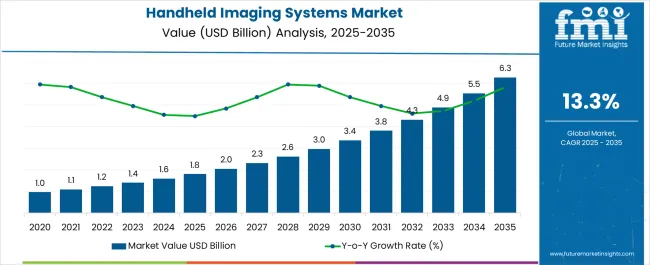
| Metric | Value |
|---|---|
| Handheld Imaging Systems Market Estimated Value in (2025 E) | USD 1.8 billion |
| Handheld Imaging Systems Market Forecast Value in (2035 F) | USD 6.3 billion |
| Forecast CAGR (2025 to 2035) | 13.3% |
The Handheld Imaging Systems market is experiencing significant growth driven by the increasing demand for portable and point-of-care diagnostic solutions. The future outlook of this market is shaped by advancements in imaging technology that allow high-quality diagnostics to be performed outside traditional clinical settings. Growing emphasis on early diagnosis, rapid patient assessment, and cost-effective healthcare delivery is fueling adoption across hospitals and outpatient facilities.
Continuous improvements in wireless connectivity, compact design, and user-friendly interfaces are enhancing operational efficiency and enabling real-time data sharing. The market is further supported by rising healthcare expenditure, expansion of healthcare infrastructure, and the shift towards preventive care models.
Additionally, the increasing prevalence of chronic diseases and the need for rapid bedside diagnostics have made handheld imaging systems an attractive choice for clinicians As hospitals and healthcare providers seek solutions that improve workflow and reduce patient wait times, the market is poised for sustained growth, particularly in regions with expanding medical facilities and a focus on innovative diagnostic technologies.
The handheld imaging systems market is segmented by device type, modality, end users, and geographic regions. By device type, handheld imaging systems market is divided into Ultrasound Systems, Mobile X-Ray Systems, Portable CT Scanners, and OCT Based Scanners. In terms of modality, handheld imaging systems market is classified into Wireless and Wired. Based on end users, handheld imaging systems market is segmented into Hospital, Diagnostic Centers, Ambulatory Surgical Center, Ambulatory Care Center, and Specialty Clinics. Regionally, the handheld imaging systems industry is classified into North America, Latin America, Western Europe, Eastern Europe, Balkan & Baltic Countries, Russia & Belarus, Central Asia, East Asia, South Asia & Pacific, and the Middle East & Africa.
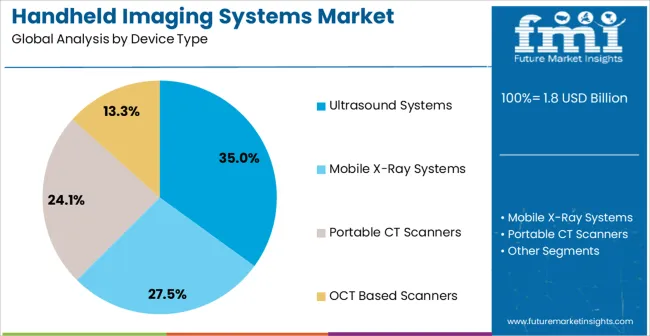
The ultrasound systems segment is projected to hold 35.0% of the handheld imaging systems market revenue share in 2025, making it the leading device type. This dominance is driven by the versatility of ultrasound technology, which allows for non-invasive, real-time imaging for a variety of clinical applications.
The segment has benefited from improvements in image resolution, portability, and ease of use, which enhance bedside diagnostics and point-of-care assessments. Growing demand for portable ultrasound solutions in emergency care, cardiology, and maternal health has reinforced the adoption of this device type.
Additionally, the integration of software-enabled features and wireless connectivity has increased operational efficiency and facilitated remote monitoring The high clinical utility, combined with the growing focus on rapid and accurate diagnostics, continues to drive the prominence of the ultrasound systems segment within handheld imaging devices.
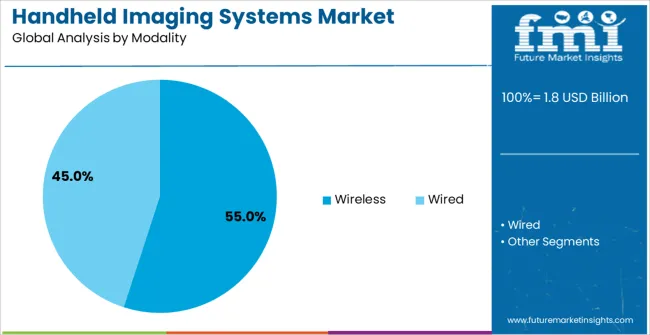
The wireless modality segment is expected to capture 55.0% of the handheld imaging systems market revenue share in 2025, establishing it as the leading modality. This growth has been influenced by the increasing need for mobility, ease of access, and real-time data transmission in clinical environments.
Wireless systems allow imaging to be performed at the patient’s bedside or in remote locations without cumbersome cabling, supporting faster decision-making and improved patient outcomes. The adoption of wireless modalities is further driven by integration with mobile devices, cloud storage, and healthcare IT systems, enabling seamless data sharing and telemedicine applications.
The flexibility, scalability, and convenience offered by wireless handheld imaging systems continue to make this modality the preferred choice for healthcare providers seeking efficient and innovative diagnostic solutions.
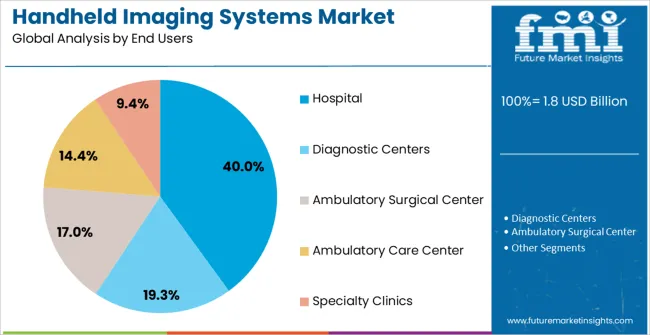
The hospital segment is anticipated to account for 40.0% of the handheld imaging systems market revenue in 2025, making it the leading end-user category. This growth is fueled by the increasing adoption of portable imaging solutions to improve patient workflow, reduce examination times, and enhance diagnostic accuracy in hospital settings.
Handheld imaging systems provide clinicians with point-of-care diagnostic capabilities that enable rapid assessment in emergency rooms, intensive care units, and inpatient wards. The integration of these devices with hospital information systems allows for streamlined data management and supports timely clinical decisions.
Rising hospital investments in advanced diagnostic equipment, coupled with a focus on improving patient care efficiency and expanding service offerings, have reinforced the adoption of handheld imaging systems The growing emphasis on technology-driven healthcare and operational optimization continues to drive the dominance of the hospital segment in the market.
Handheld Imaging Systems are defined by the accessibility the devices offer in terms of portability of nature of the device. The device readily offers output creating a Nobel way for diagnosis. The handheld devices work on the principal of compacting the imaging technology in an easily accessible way.
According to the type of handheld devices, the working principle alters. The handheld imaging systems assist in a quantifiable assessment of body part and disease condition providing help in leading to precise and effective recommendations to the operator.
New generation advanced handheld imaging system provides advancement informal examination that is interpreted in 3 dimensions, the retinas ocular health can be assessed on the devices. Additionally, the ear infection or the bacterial colonization in the ear can be assayed easily.
The growth of the handheld imaging systems market is directly related to the innovation and research in the microchip technologies, resulting in the more proclaimed application in the diagnosis and devices industry.
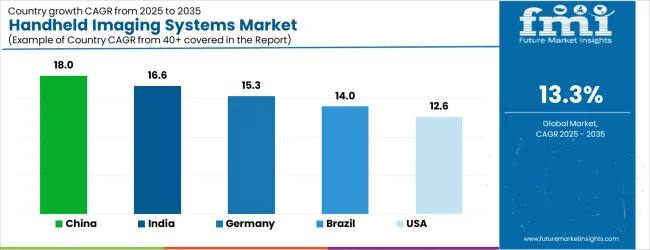
| Country | CAGR |
|---|---|
| China | 18.0% |
| India | 16.6% |
| Germany | 15.3% |
| Brazil | 14.0% |
| USA | 12.6% |
| UK | 11.3% |
| Japan | 10.0% |
The Handheld Imaging Systems Market is expected to register a CAGR of 13.3% during the forecast period, exhibiting varied country level momentum. China leads with the highest CAGR of 18.0%, followed by India at 16.6%. Developed markets such as Germany, France, and the UK continue to expand steadily, while the USA is likely to grow at consistent rates. Japan posts the lowest CAGR at 10.0%, yet still underscores a broadly positive trajectory for the global Handheld Imaging Systems Market. In 2024, Germany held a dominant revenue in the Western Europe market and is expected to grow with a CAGR of 15.3%. The USA Handheld Imaging Systems Market is estimated to be valued at USD 677.9 million in 2025 and is anticipated to reach a valuation of USD 677.9 million by 2035. Sales are projected to rise at a CAGR of 0.0% over the forecast period between 2025 and 2035. While Japan and South Korea markets are estimated to be valued at USD 86.6 million and USD 48.2 million respectively in 2025.
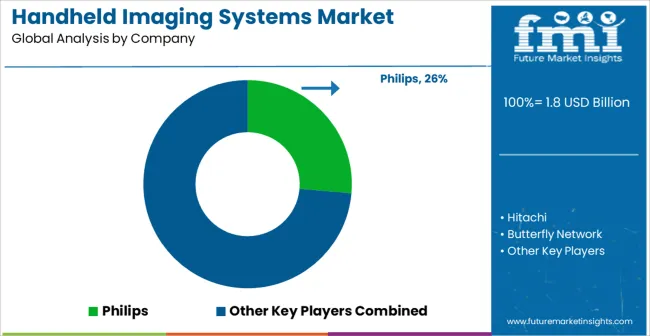
| Item | Value |
|---|---|
| Quantitative Units | USD 1.8 Billion |
| Device Type | Ultrasound Systems, Mobile X-Ray Systems, Portable CT Scanners, and OCT Based Scanners |
| Modality | Wireless and Wired |
| End Users | Hospital, Diagnostic Centers, Ambulatory Surgical Center, Ambulatory Care Center, and Specialty Clinics |
| Regions Covered | North America, Europe, Asia-Pacific, Latin America, Middle East & Africa |
| Country Covered | United States, Canada, Germany, France, United Kingdom, China, Japan, India, Brazil, South Africa |
| Key Companies Profiled | Philips, Hitachi, Butterfly Network, Analogic, GE, Fujifilm Holdings, Samsung, Shimadzu, and Siemens |
The global handheld imaging systems market is estimated to be valued at USD 1.8 billion in 2025.
The market size for the handheld imaging systems market is projected to reach USD 6.3 billion by 2035.
The handheld imaging systems market is expected to grow at a 13.3% CAGR between 2025 and 2035.
The key product types in handheld imaging systems market are ultrasound systems, mobile X-Ray systems, portable CT scanners and oct based scanners.
In terms of modality, wireless segment to command 55.0% share in the handheld imaging systems market in 2025.






Our Research Products

The "Full Research Suite" delivers actionable market intel, deep dives on markets or technologies, so clients act faster, cut risk, and unlock growth.

The Leaderboard benchmarks and ranks top vendors, classifying them as Established Leaders, Leading Challengers, or Disruptors & Challengers.

Locates where complements amplify value and substitutes erode it, forecasting net impact by horizon

We deliver granular, decision-grade intel: market sizing, 5-year forecasts, pricing, adoption, usage, revenue, and operational KPIs—plus competitor tracking, regulation, and value chains—across 60 countries broadly.

Spot the shifts before they hit your P&L. We track inflection points, adoption curves, pricing moves, and ecosystem plays to show where demand is heading, why it is changing, and what to do next across high-growth markets and disruptive tech

Real-time reads of user behavior. We track shifting priorities, perceptions of today’s and next-gen services, and provider experience, then pace how fast tech moves from trial to adoption, blending buyer, consumer, and channel inputs with social signals (#WhySwitch, #UX).

Partner with our analyst team to build a custom report designed around your business priorities. From analysing market trends to assessing competitors or crafting bespoke datasets, we tailor insights to your needs.
Supplier Intelligence
Discovery & Profiling
Capacity & Footprint
Performance & Risk
Compliance & Governance
Commercial Readiness
Who Supplies Whom
Scorecards & Shortlists
Playbooks & Docs
Category Intelligence
Definition & Scope
Demand & Use Cases
Cost Drivers
Market Structure
Supply Chain Map
Trade & Policy
Operating Norms
Deliverables
Buyer Intelligence
Account Basics
Spend & Scope
Procurement Model
Vendor Requirements
Terms & Policies
Entry Strategy
Pain Points & Triggers
Outputs
Pricing Analysis
Benchmarks
Trends
Should-Cost
Indexation
Landed Cost
Commercial Terms
Deliverables
Brand Analysis
Positioning & Value Prop
Share & Presence
Customer Evidence
Go-to-Market
Digital & Reputation
Compliance & Trust
KPIs & Gaps
Outputs
Full Research Suite comprises of:
Market outlook & trends analysis
Interviews & case studies
Strategic recommendations
Vendor profiles & capabilities analysis
5-year forecasts
8 regions and 60+ country-level data splits
Market segment data splits
12 months of continuous data updates
DELIVERED AS:
PDF EXCEL ONLINE
Handheld Dental X-Ray Systems Market Analysis - Size, Share, and Forecast 2025 to 2035
Urology Imaging Systems Market Size and Share Forecast Outlook 2025 to 2035
In Vivo Imaging Systems Market Size and Share Forecast Outlook 2025 to 2035
Vascular Imaging Systems Market Growth - Trends & Forecast 2025 to 2035
Chemical Imaging Systems Market
Pathology Imaging Systems Market Size and Share Forecast Outlook 2025 to 2035
Widefield Imaging Systems Market Insights - Growth & Forecast 2025 to 2035
Angiography Imaging Systems Market Size and Share Forecast Outlook 2025 to 2035
Macroscopic Imaging Systems Market
New Born Eye Imaging Systems Market Size and Share Forecast Outlook 2025 to 2035
Ultraviolet Transilluminator Imaging Systems Market Size and Share Forecast Outlook 2025 to 2035
Handheld Electrostatic Meter Market Size and Share Forecast Outlook 2025 to 2035
Handheld Ultrasound Scanner Market Size and Share Forecast Outlook 2025 to 2035
Handheld Tagging Gun Market Forecast and Outlook 2025 to 2035
Handheld XRF Analyzers Market Size and Share Forecast Outlook 2025 to 2035
Handheld Police Radar Guns Market Size and Share Forecast Outlook 2025 to 2035
Handheld DNA Reader Market Size and Share Forecast Outlook 2025 to 2035
Handheld Robotic Navigation Market Analysis - Size, Share, and Forecast Outlook 2025 to 2035
Handheld Mesh Nebulizer Market Size and Share Forecast Outlook 2025 to 2035
Handheld Chemical and Metal Detector Market Size and Share Forecast Outlook 2025 to 2035

Thank you!
You will receive an email from our Business Development Manager. Please be sure to check your SPAM/JUNK folder too.
Chat With
MaRIA